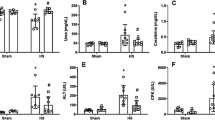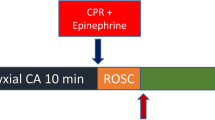Abstract
Objective
We investigated whether hypoxemic resuscitation from hemorrhagic shock prevents the late circulatory instability and attenuates the oxidative and inflammatory responses associated with the standard strategy.
Design and setting
Prospective, randomized, controlled animal study in an experimental laboratory of a university intensive care unit.
Subjects
Thirty-one New Zealand white rabbits weighting 3.1–3.4 kg
Interventions
Anesthetized animals were subjected to hemorrhagic shock by exsanguinations to a mean arterial pressure of 40 mmHg for 60 min. Resuscitation was performed by reinfusing the shed blood for 30 min under normoxemia (PaO2 95–105 mmHg, control group, n = 10) or hypoxemia (PaO2 35–40 mmHg, hypox-res group, n = 10); Ringer's lactate was given from 30 to 60 min to restore arterial pressure within baseline values. A sham group was assigned (n = 11). Animals were recorded for 120 min postresuscitation and for further 360 min to assess the early mortality rate.
Measurements and results
Hypoxemic resuscitation compared with normoxemic resuscitation from hemorrhagic shock was associated with (a) a better hemodynamic condition assessed by the gradual restoration of blood pressure, higher urinary output associated with less fluid infusion; (b) lower reactive oxygen species production assessed by the reduced blood geometric mean fluorescence intensity, lower malondialdehyde, and higher ratio of reduced to total glutathione levels; (c) attenuation in the plasma concentrations of IL-1β, TNF-α, and IL-6; and (d) no difference in mortality rate.
Conclusions
Hypoxemic resuscitation from hemorrhagic shock is more efficient than normoxemic in restoring the blood pressure and in attenuating the excessive oxidative and inflammatory responses observed during normoxemic resuscitation.




Similar content being viewed by others
References
Kerner T, Ahlers O, Veit S, Riou B, Saunders M, Pison U for the European DCLHb Trauma Study Group (2003) DCL-Hb for trauma patients with severe hemorrhagic shock: the European “On-Scene” multicenter study. Intensive Care Med 29:378–385
Bilkovski RN, Rivers EP, Horst HM (2004) Targeted resuscitation strategies after injury. Curr Opin Crit Care 10:529–538
Revell M, Greaves I, Porter K (2003) Endpoints for fluid resuscitation in hemorrhagic shock. J Trauma 54:S63–S67
Roberts I, Alderson P, Bunn F, Chinnock P, Ker K, Schierhout G (2004) Colloids versus crystalloids for fluid resuscitation in critically ill patients. Cochrane Database Syst Rev CD000567
Bickell WH, Wall MJ Jr, Pepe PE, Martin RR, Ginger VF, Allen MK, Mattox KL (1994) Immediate versus delayed resuscitation for hypotensive patients with penetrating torso injuries. N Engl J Med 331:1105–1109
Cavanaugh BP, Meyer LJ (2005) Normalizing physiological variables in acute illness: five reasons for caution. Intensive Care Med 31:1161–1167
Roberts I, Evans P, Bunn F, Kwan I, Crowhurst E (2001) Is the normalization of blood pressure in bleeding trauma patients harmful? Lancet 357:385–387
Stern SA (2001) Low-volume fluid resuscitation for presumed hemorrhagic shock: helpful or harmful? Curr Opin Crit Care 7:422–430
Shafi S, Kauder D (2004) Fluid resuscitation and blood transfusion in patients with polytrauma. Clin Orthop 422:37–42
Li C, Jackson RM (2002) Reactive species mechanisms of cellular hypoxia-reoxygenation injury. Am J Physiol Cell Physiol 282:C227–C241
Granger DN, Korthious RJ (1995) Physiologic mechanisms of postischemic tissue injury. Annu Rev Physiol 57:311–332
Droge W (2002) Free radicals in the physiological control of cell function. Physiol Rev 82:47–95
Therade-Matharan E, Laemmel E, Duranteau J, Vicaut E (2004) Reactive oxygen species production by mitochondria in endothelial cells exposed to reoxygenation after hypoxia and glucose depletion is mediated by ceramide. Am J Physiol Regul Integr Comp Physiol 287:R1037–R1043
Tamion F, Richard V, Bonmarchand G, Leroy J, Hiron M, Daveau M, Thuillez C, Lebreton JP (2000) Reduced synthesis of inflammatory cytokines by a free radical scavenger after hemorrhagic shock in rats. Crit Care Med 28:2522–2527
Perry MA, Wadhwa SS (1988) Gradual reintroduction of oxygen reduces reperfusion injury in cat stomach. Am J Physiol 254:G366–G372
Douzinas EE, Livaditi O, Xiarchos AG, Giamarellos-Bourboulis EJ, Villiotou V, Liappas IA, Evangelou E, Rapidis AD, Roussos C (2006) The effect of hypoxemic resuscitation of hemorrhagic shock on hemodynamic stabilization and inflammatory response: a pilot study in a rat experimental model. J Trauma 61:918–923
Victor VM, De La Fuente M (2003) Several Functions of immune cells in mice changed by oxidative stress caused by endotoxin. Physiol Res 52:789–796
Agarwal R, Chase SD (2002) Rapid, fluorimetric-liquid chromatographic determination of malondialdehyde in biological samples. J Chromatogr B Analyt Technol Biomed Life Sci 775:121–126
Douzinas EE, Livaditi O, Tasoulis M-K, Pelekanou A, Giamarellos-Bourboulis EJ (2007) Stimulation of monocytes is a pathway involved in systemic inflammatory response following haemorrhagic shock resuscitation: the effect of hypoxaemic resuscitation. Clin Exp Immunol (in press)
McGill MW, Rowan AN (1989) Biological effects of blood loss: implications from sampling volumes and techniques. ILAR News 31:5–20
Escobar GA, Cheng AM, Moore EE, Johnson JL, Tannahill C, Baker HV, Moldawer LL, Banerjee A (2007) Stored packed red blood cell transfusion up-regulates inflammatory gene expression in circulating leukocytes. Ann Surg 246:129–134
Flom-Halvorsen HI, Ovrum E, Oystese R, Brosstad F (2003) Quality of intraoperative autologus blood withdrawal used for retransfusion after cardiopulmonary bypass. Ann Thorac Surg 76:744–748
Lenfant C, Aucutt C (1965) Oxygen uptake and change in carbon dioxide tension in human blood stored at 37 °C. J Appl Physiol 20:503–508
Powers KA, Woo J, Khadaroo RG, Papia G, Kapus A, Rotstein OD (2003) Hypertonic resuscitation of hemorrhagic shock upregulates the anti-inflammatory response by alveolar macrophages. Surgery 134:312–318
Haase E, Bigam DL, Nakonechny QB, Jewell LD, Korbutt G, Cheung PY (2004) Resuscitation with 100% oxygen causes intestinal glutathione oxidation and reoxygenation injury in asphyxiated newborn piglets. Ann Surg 240:364–373
Douzinas EE, Pitaridis MT, Patsouris E, Kollias S, Boursinos V, Karmpaliotis DI, Gratsias Y, Evangelou E, Papalois A, Konstantinidou AE, Roussos C (2003) Myocardial ischemia in intestinal postischemic shock: the effect of hypoxemic reperfusion. Crit Care Med 31:2183–2189
Fisher AB, Dodia C, Tan ZT, Ayene I, Eckenhoff RG (1991) Oxygen-dependent Lipid Peroxidation during Lung Ischemia. J Clin Invest 88:674–679
Douzinas EE, Andrianakis I, Pitaridis MT, Karmpaliotis DJ, Kypriades EM, Katsouyanni K, Betsou A, Gratsias Y, Papalois A, Roussos C (2001) The effect of hypoxemic reperfusion on cerebral protection after a severe global ischemic brain insult. Intensive Care Med 27:269–275
Douzinas EE, Patsouris E, Kypriades E, Andrianakis I, Makris DJ, Korkolopoulou P, Sotiropoulou C, Boursinos V, Davaris P, Roussos C (2001) Hypoxemic reperfusion ameliorates the histopathologic changes in the brain after a severe global cerebral ischemic insult. Intensive Care Med 27:905–910
Luchette FA, Jenkins WA, Friend LA, Su C, Fischer JE, James JH (2002) Hypoxia is not the sole cause of lactate production during shock. J Trauma 52:415–419
Levy B, Mansart A, Montemont C, Gibot S, Mallie JP, Regnault V, Lecompte T, Lacolley P (2007) Myocardial lactate deprivation is associated with decreased cardiovascular performance, decreased myocardial energetics, and early death in endotoxic shock. Intensive Care Med 33:495–502
Acknowledgements
The authors are grateful to Stephen Poole, PhD, of National Institute for Biological Standards and Control, UK, for his kind contribution in the preparation of rabbit enzyme-linked immunosorbent assay kits for the needs of the measurements. The authors also thank L. Haziroglou, BSc, for his editorial assistance and language review.
Author information
Authors and Affiliations
Corresponding author
Rights and permissions
About this article
Cite this article
Douzinas, E.E., Livaditi, O., Andrianakis, I. et al. The effect of hypoxemic resuscitationfrom hemorrhagic shock on blood pressure restoration and on oxidative and inflammatory responses. Intensive Care Med 34, 1133–1141 (2008). https://doi.org/10.1007/s00134-007-0940-4
Received:
Accepted:
Published:
Issue Date:
DOI: https://doi.org/10.1007/s00134-007-0940-4




